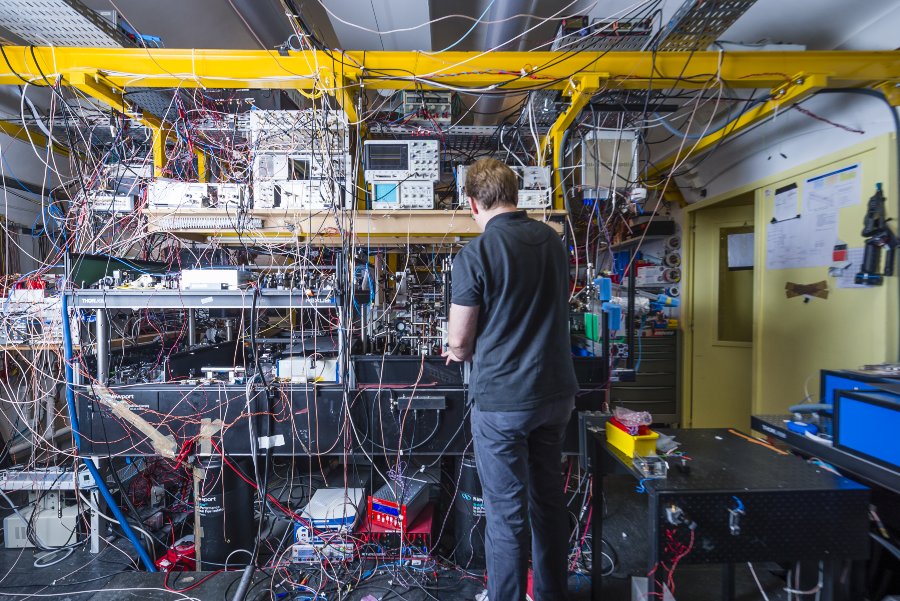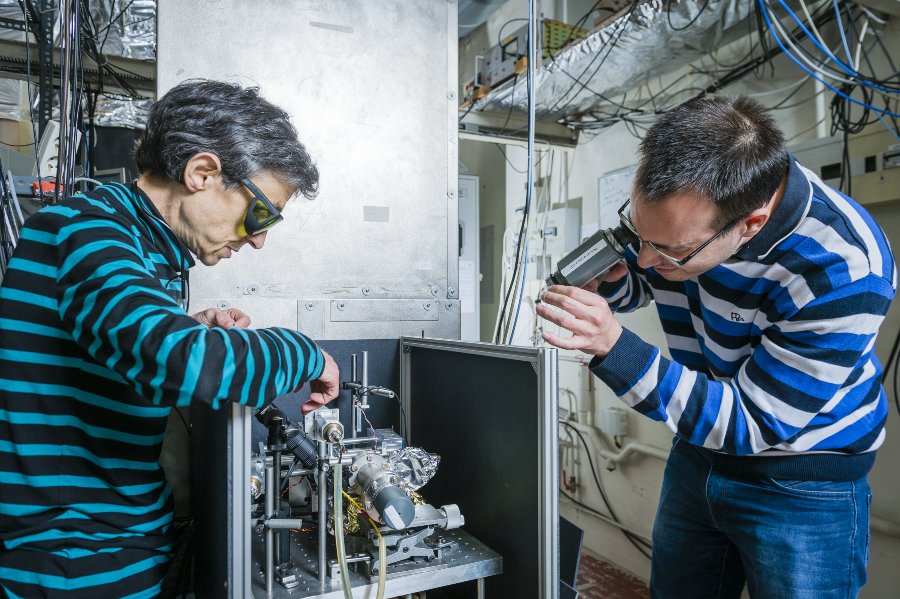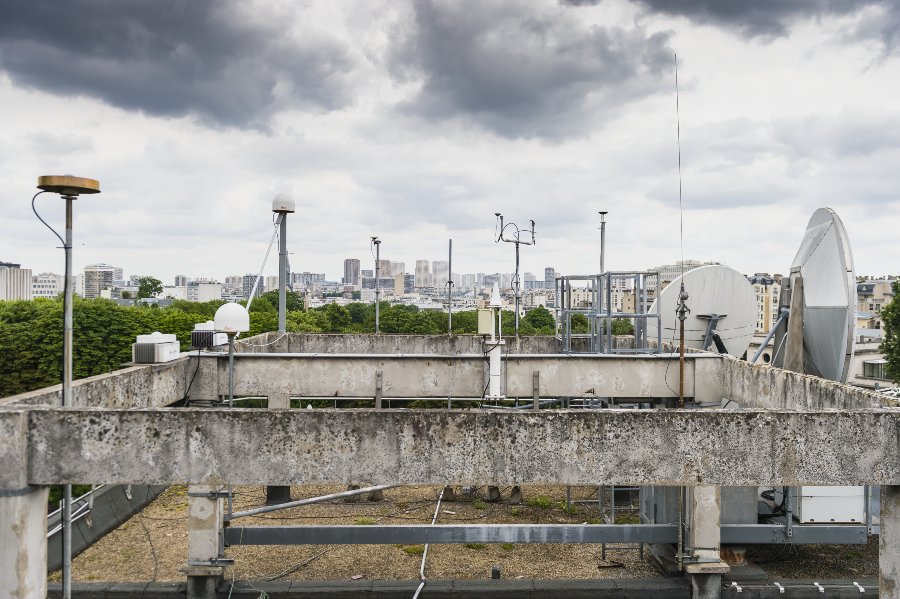Activities Time-Frequency:
Workforce: 90with: 40 permanents, 50 non-permanent
PARIS, France
The SYRTE, more specifically its division known as the LNE-SYRTE, has a mandate from the National Laboratory of Metrology and Testing (LNE) for realizing the national references for time and frequency, ensuring their traceability at the international level and making them available to users. It develops ambitious research programs in the field of time and frequency, especially concerning microwave and optical frequency standards, time scales and comparisons between frequency and time standards operating in different spectral domains and/or at long distances (continental or intercontinental) from each other. In this work it uses and develops many experimental techniques, such as precision mechanical engineering, RF and microwave electronics, optics, laser cooling and manipulation of atoms, spectroscopy, oscillator and laser stabilisation, optical frequency combs, etc. It realizes and makes available the unit of time, the second, the national time scale UTC(OP) and legal time, and French atomic time TA(F) in partnership with a network of French laboratories. It collaborates with the International Bureau of Weights and Measures (BIPM) to contribute to the international reference time UTC and to ensure the traceability of UTC(OP). It also carries out advanced research in the field of inertial sensors based on atomic interferometry, and is charged by the LNE with a mission in gravimetry. It applies these capabilities in other areas of research such as fundamental physics, geodesy, gravitational waves, etc. It participates in major projects and networks in all areas of its work. It has many industrial collaborations and attaches a particular importance to technology transfer to industry. Other divisions of SYRTE work in related fields such as VLBI, celestial reference systems, Earth rotation, and the history of astronomy and science.
Expertise :
- Oscillators
- RF and microwave oscillators and synthesis
- Microwave technologies• Low phase noise oscillators and frequency chainsmicrowave synthesis from optical sources
- Disciplined oscillators• Digital and analog PLL with a large spectrum of performance and caracteristic timescales (from a few 100 nanoseconds to several days for feed-back time constant)
- Optical oscillators, lasers
- Lasers locked to a Fabry-Pérot cavity• Realization and utilization of multiple systems (>10) operating at various wavelengths from the visible to the near IR.
Cavity length from 10cm to 40cm - Lasers locked to a fibre delay line• Past R&D activity. Utilization of existing systems in experiments
- Lasers locked with Spectral Hole Burning effect (SHB)• On going R&D project. Servo loop using digital technique Development of ultra-low vibration closed-cycle cryostat.
- Lasers locked to an atomic or molecular line• Several optical frequency standards of extremely high absolute accuracy (2 Strontium Sr, 1 Mercury Hg)
Compact and high performance optical frequency standard based on molecular transition in iodine I2 - Frequency combs• Multiple fully functional systems (1 Ti:Sapphire Titane Sapphire, 5 Erbium Er-doped fiber systems)
Operationnal activity with continuous measurement for months
Transfer of spectral purity between wavelengths
Ultra-low phase noise microwave signal gen - Laser sources• Developments of extended cavity diode lasers technologies
Frequency locking of lasers on external cavities or atomic/molecular lines
Amplitude stabilization of laser sources
- Lasers locked to a Fabry-Pérot cavity• Realization and utilization of multiple systems (>10) operating at various wavelengths from the visible to the near IR.
- RF and microwave oscillators and synthesis
- Atomic references
- Micro-wave clocks and subsystems
- Cold atoms• Atomic fountain clocks
Cold atom space clock (ACES/PHARAO)
Isotropic light cooling clock
Cesium Cs, Rubidium Rb - Thermal beam clocks• Past R&D and continuous operation during several years
- Optical pumping cell clocks• Past R&D activity, industrial transfer
- Coherent population trapping (CPT) clocks• Continuous interrogation
Pulsed interrogation (Ramsey)
Laser frequency generation by direct modulation, electro-optical modulator (EOM), phase locking (PLL)
Polarisation modulation - Masers• Utilization for timescales
- Cold atoms• Atomic fountain clocks
- Optical clocks and subsystems
- Optical neutral atomic clocks• 3 ultra-high performance (accurracy and stability) systems: 2 Strontium Sr, 1 Mercury Hg
Use of non destructive measurements for improving short term stability
- Optical neutral atomic clocks• 3 ultra-high performance (accurracy and stability) systems: 2 Strontium Sr, 1 Mercury Hg
- Micro-wave clocks and subsystems
- Synchronisation, frequency transfer and time scales
- Micro-wave links
- GNSS• GPS, GLONASS, Galileo, EGNOS
Galileo System Time, EGNOS Network Time
Single and dual frequency
Code and phase methods: P3, PPP, etc
Relative and absolute receiver calibration - Two way systems• Two Way Satellite Time and Frequency Transfer
Satellite simulator
Calibration
Code and phase
Software-defined radio modem
Modeling of the ACES micro-wave link (MWL) - Radio links• France Inter
- Wired links• Local high-performance time and frequency distribution
- GNSS• GPS, GLONASS, Galileo, EGNOS
- Optical links in free space
- Pulsed optical links in free space• Collaboration with the T2L2 experiment of OCA/Geoazur
- Continuous optical links in free space• Past R&D activity
- Fibred optical links
- Data transfer on a fibre network• Local area and long-distance time and frequency transfer on packet-switched networks
Dual fibre, uni-directional
Protocols: NTP, PTP, White Rabbit - Purely optical methods• Ultra-stable optical carrier frequency transfer
Bi-directional dark channel
Repeater laser station
RF and time transfer
- Data transfer on a fibre network• Local area and long-distance time and frequency transfer on packet-switched networks
- Time scales• Realisation of highly stable and accurate time scales, steered using primary and secondary frequency standards (atomic fountains, optical clocks)
Realisation of the national reference time scale UTC(OP), the basis for legal time
Steering remote time scales
Realisation of French Atomic Time, TA(F)
- Micro-wave links
- Specific methods of time-frequency metrology
- Noise
- Phase noise, PLL• RF and microwave domains
Optical domain
Very low phase noise
Frequency agility - Intensity noise• Amplitude servo of continuous and pulsed lasers
- Short term stability, long term stability• Variances and deviations (Allan, ADEV, MDEV, TDEV)
Characterisation of oscillator and laser stability
Characterisation of atomic clock stability
Characterisation of time and frequency transfer stability
- Phase noise, PLL• RF and microwave domains
- Systematics, Accuracy, Calibration
- Systematics in atom-light interaction• Black body radiation shift
collisional shiftlight shift
distributed cavity phase shift
wavefront aberrations
Stark and Zeeman effects - Systematics in time transfer methods• Ionospheric delay
chromatic dispersion of optical fibre
electronic delay calibration
- Systematics in atom-light interaction• Black body radiation shift
- High resolution spetroscopy
- Atomic spectroscopy• Atomic frequency references (Cesium Cs, Rubidium Rb, Strontium Sr, Mercury Hg, Europium 3+ Eu3+)
- Molecular spectroscopy• Molecular frequency references (Iodine I2)
- Noise
- Techniques for time-frequency metrology and applications
- Electronics
- Analog electronics• Design, realization and test of low current and voltage noise circuits
low noise photodiodes from DC to microwave ultra low phase noise RF and microwave circuit servo loops frequency multiplication and division - Digital electronics• Utlization of ADC, DAC, FPGA, Micro-controlers and computer control of complex experimental apparatus
- Acquisition, interfaces, converters• Utlization of ADC, DAC, sampling frequencie from the kHz to the GHz range
- Analog electronics• Design, realization and test of low current and voltage noise circuits
- Mechanics, Ultra-high vacuum, Cryogenics• Design and realization of precision mechanicsdesign and realization of ultra-high vacuum systemsutilization and characterization of low noise 4K cryostats
- Optics
- Guided optics, specific optical fibres• Utilization of SMF, PM and PCF fibres at various wavelengths in the visible and near IR domains
noise cancelling of short (meter) to continental scale fiber links
highly stable PM and SM beam splitters
waveguide optical frequency doublers - High sensitivity, low noise photodetectors• InGaAs Indium gallium arsenide and Si Silicon
GaAs Gallium arsenide photoconductors
pin MUTC photodiode - Control of the optical beam characteristics• Beam shape analizis
Shack-Hartmann
measure and servo of beam power
measure and servo of beam pointing instability
- Guided optics, specific optical fibres• Utilization of SMF, PM and PCF fibres at various wavelengths in the visible and near IR domains
- Cooling or trapping techniques
- Cooling, trapping of atoms• Laser cooling methods: optical molasses, 2D and 3D magneto-optical traps (MOT), isotropic light, evaporative cooling (optical, magnetic), optical lattices, dipolar traps, cooling and trapping on chip
Ultra-cold atoms
On-demand realization of cold atomic sources (2D optical magnetic traps)
- Cooling, trapping of atoms• Laser cooling methods: optical molasses, 2D and 3D magneto-optical traps (MOT), isotropic light, evaporative cooling (optical, magnetic), optical lattices, dipolar traps, cooling and trapping on chip
- Interferometry techniques
- Atom interferometry techniques• Atomic beam splitter (Raman, Bragg)
Atoms in free fall
Trapped and guided atoms
- Atom interferometry techniques• Atomic beam splitter (Raman, Bragg)
- Sensors
- Atomic inertial sensors• Cold atom absolute gravimeters, gradiometers and gyrometers
Cold atoms in free fall, optical lattices, trapped and guided on atom chips
Accelerometer of the giant interferometer MIGA
- Atomic inertial sensors• Cold atom absolute gravimeters, gradiometers and gyrometers
- Electronics
Connected Sectors:
- Fundamental science
- Fundamental metrology• Definition and realisation of the SI second
Calibration of TAI
Contribution to UTC
French legal time
Gravimeter for the Watt balance - Tests of fundamental physics• Test of the equivalence principle, Lorentz invariance
Search for variations of the fundamental constants
Search for effects of dark matter on atomic clocks
Study of the Casimir-Polder effect
Tests of forces at short distances - Astronomy, astrophysics (radioastronomy, VLBI, gravitational waves sensors)• MIGA
LISA
earth rotation
celestial reference frames
expertise and support for timescales and synchronisation for astronomy
- Fundamental metrology• Definition and realisation of the SI second
- Positioning and navigation
- Satellite positioning, GNSS• Contributions to the EGNOS and Galileo time scales, notably to the link to UTC
- Inertial navigation• Development of new atomic clock and sensor technologies and transfer to industry
- Radar• Development of low noise microwave sources
- Network synchronisation
- Telecommunications• Expertise and support for the provision of time and frequency references (syntonisation and synchronisation) to industry and other users.
Synchronisation of telecom operators - Cyber security• Expertise and support for the provision of time and frequency references (syntonisation and synchronisation) to industry and other users.
- Smart grids• Expertise and support for the provision of time and frequency references (syntonisation and synchronisation) to industry and other users.
- Bank transactions• Expertise and support for the provision of time and frequency references (syntonisation and synchronisation) to industry and other users.
- Transportation networks
- Telecommunications• Expertise and support for the provision of time and frequency references (syntonisation and synchronisation) to industry and other users.
- Environment and health
- Geoscience (geodesy, geophysics)• Chronometric levelling
High-sensitivity absolute atomic gravimeter
- Geoscience (geodesy, geophysics)• Chronometric levelling
- Arts, Languages, human and social sciences
- Concepts of precision and accuracy• Definition and metrological characterisation of uncertainty
- History of science, philosophy• Historical instruments
Development of the concept of measurement precision (17th-18th centuries) - Arts• Support for sundial design




